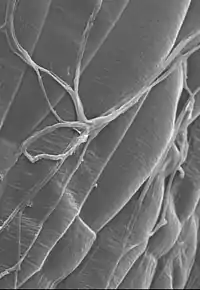Epichloë festucae
Epichloë festucae is a systemic and seed-transmissible endophytic fungus of cool season grasses.[1]
| Epichloë festucae | |
|---|---|
 | |
| Scientific classification | |
| Kingdom: | Fungi |
| Division: | Ascomycota |
| Class: | Sordariomycetes |
| Order: | Hypocreales |
| Family: | Clavicipitaceae |
| Genus: | Epichloë |
| Species: | E. festucae |
| Binomial name | |
| Epichloë festucae Leuchtm., Schardl & M.R. Siegel | |
| Synonyms | |
| |
First described in 1994,[2] Epichloë festucae is a sister lineage to Epichloë amarillans, Epichloë baconii, Epichloë mollis and Epichloë stromatolonga. Epichloë festucae is found across North America, where it lives in the grass species Bromus kalmii and Elymus spp. (including Elymus patula).
Genome
The complete genome sequence of Epichloë festucae, the first complete genome sequence of any species in the genus Epichloë, was reported in 2018. The 35 Mb genome comprises 7 chromosomes, ranging from 3.2 to 7.8 Mb, including approximately 9,000 genes.[3]
Varieties
Epichloë festucae strains can have both a sexual reproductive morph (teleomorph) and an asexual reproductive morph (anamorph). For this group, the anamorph forms were long classified separately: initially in the genus Acremonium,[4] and after 1996, in the new genus Neotyphodium.[5] Since 2011, the nomenclatural code has required that a single name be used for all stages of development of a fungal species, and following a taxonomic revision of the genus Epichloë in 2014, the asexual forms of Epichloë festucae are now classified as Epichloë festucae var. lolii.[1]
Found across Europe, Asia and North Africa, and introduced in New Zealand, Australia and elsewhere, Epichloë festucae var. lolii is associated with the grass species Lolium perenne subsp. perenne.
References
- Leuchtmann, A.; Bacon, C. W.; Schardl, C. L.; White, J. F.; Tadych, M. (2014). "Nomenclatural realignment of Neotyphodium species with genus Epichloë". Mycologia. 106 (2): 202–215. doi:10.3852/13-251. PMID 24459125. S2CID 25222557.
- Leuchtmann, Adrian; Schardl, Christopher L.; Siegel, Malcolm R. (1994). "Sexual compatibility and taxonomy of a new species of Epichloë symbiotic with fine fescue grasses". Mycologia. 86 (6): 802–812. doi:10.1080/00275514.1994.12026487. ISSN 0027-5514.
- Winter, David J.; Ganley, Austen R. D.; Young, Carolyn A.; Liachko, Ivan; Schardl, Christopher L.; Dupont, Pierre-Yves; Berry, Daniel; Ram, Arvina; Scott, Barry; Cox, Murray P. (2018). "Repeat elements organise 3D genome structure and mediate transcription in the filamentous fungus Epichloë festucae". PLOS Genetics. 14 (10): e1007467. doi:10.1371/journal.pgen.1007467. ISSN 1553-7404. PMID 30356280.
- Morgan-Jones, G.; Gams, W. (1982). "Notes on hyphomycetes. XLI. An endophyte of Festuca arundinacea and the anamorph of Epichloe typhina, new taxa in one of two new sections of Acremonium". Mycotaxon. 15: 311–318.
- Glenn AE, Bacon CW, Price R, Hanlin RT (1996). "Molecular phylogeny of Acremonium and its taxonomic implications". Mycologia. Mycological Society of America. 88 (3): 369–383. doi:10.2307/3760878. JSTOR 3760878.